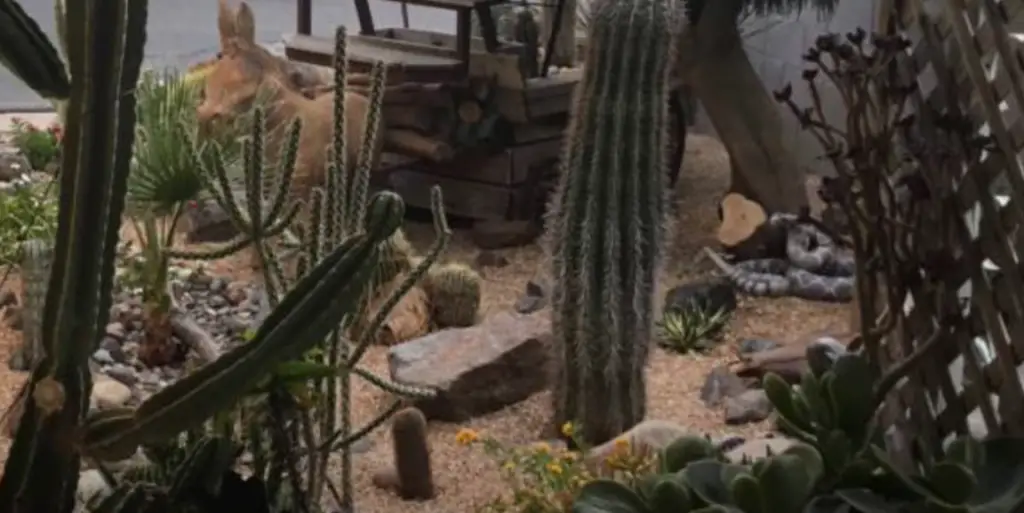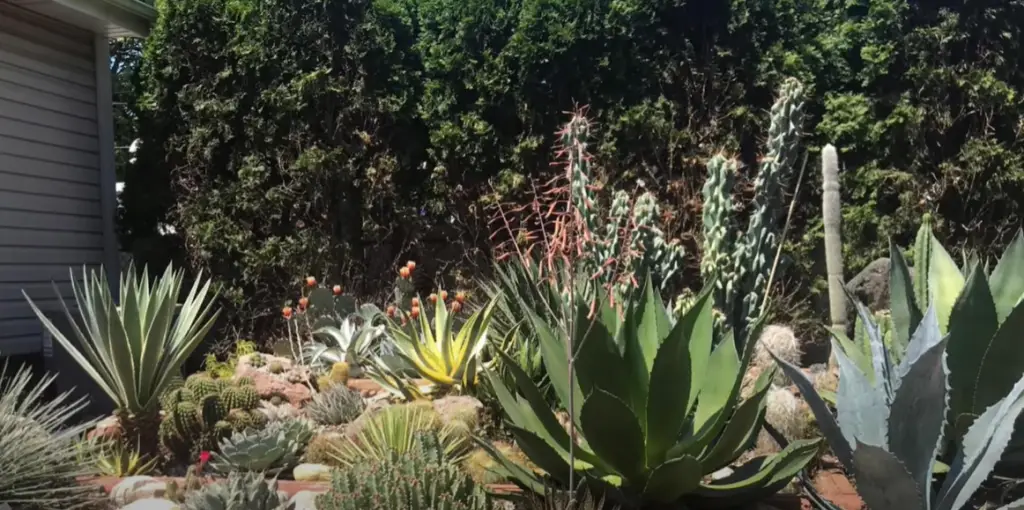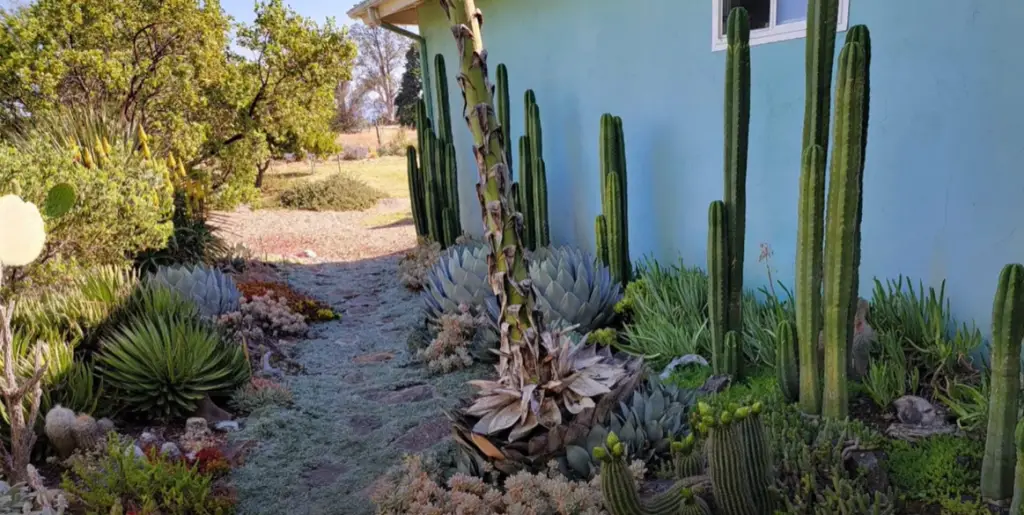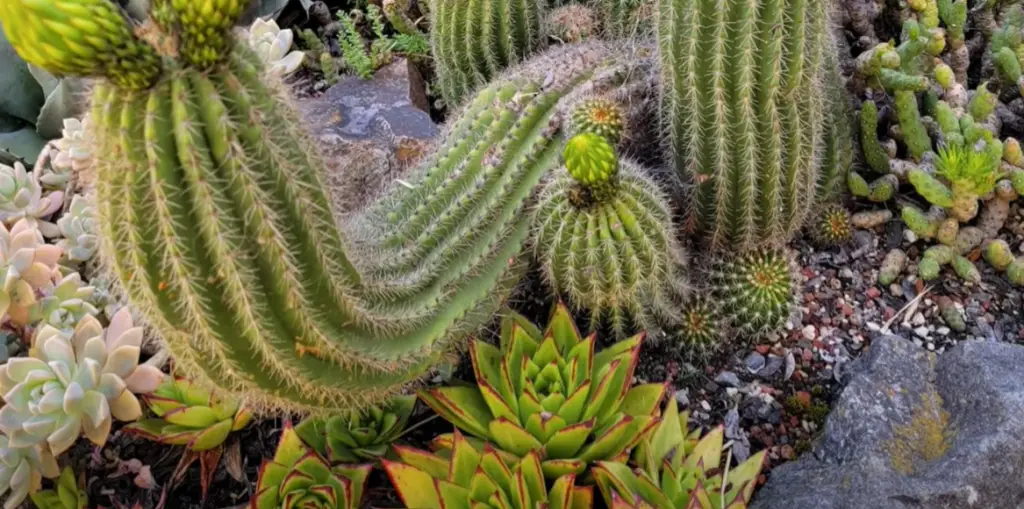Cactus gardens are becoming more and more popular, especially in dry climates. They can be a beautiful addition to any yard or garden, and they’re surprisingly easy to care for! This article will answer some common questions about cactus gardens, give you some tips on how to create one and provide some inspiration from other gardeners who have created stunning cactus gardens of their own. So, if you’re interested in creating a beautiful cactus garden of your own, read on!
What is a Cactus garden?
A cactus garden is a type of succulent garden that features plants from the Cactaceae family. These gardens are popular for their low maintenance and water-wise requirements, as well as the unique beauty they bring to outdoor spaces. Cactus gardens can be designed in many different ways – from small indoor arrangements to sprawling outdoor landscapes. Some popular choices for cactus gardens include prickly pears, chollas, saguaros, and barrel cacti.
Additionally, you should also plan out where to place the plants so that they receive adequate sunlight and can thrive in their environment. With careful planning and appropriate care, a cactus garden can easily become the highlight of any outdoor space!

Benefits of Cactus Gardens
Cactus gardens provide several benefits that make them ideal for many types of homes and gardens. First of all, these plants require very little maintenance – they do not need to be watered often or pruned regularly like other plants. This makes them an easy choice for those who have busy lives and are unable to dedicate time to gardening every day.
In addition, cacti are very drought-tolerant and can survive in areas with low rainfall or limited water availability. Furthermore, these plants can also help create a natural habitat for birds and other wildlife, making it an ideal choice for those who want to attract more wildlife into their garden. Lastly, cactus gardens bring a unique aesthetic charm that is perfect for any outdoor space!
Overall, cactus gardens are an excellent choice for those looking to add some low-maintenance beauty to their home or garden without sacrificing style or function. With the right planning and care, you can easily create a beautiful oasis full of life and color [1]!
What are the different types of garden Cactus?
There are many different types of cacti available for garden cultivation. These include:
Barrel Cactus (Ferocactus): These are large, cylindrical cacti with vertical ribs and yellow flowers. They make great accent plants in landscapes, containers, or rock gardens.
Prickly Pear Cactus (Opuntia): This is the most common cactus in gardens. It has flat pads that can be used to create interesting shapes or provide a protective barrier around other plants. The bright red fruits of this plant are edible and delicious when ripe.
Cholla Cactus (Cylindropuntia): This type of cactus is covered in short spines that resemble a fuzzy caterpillar. They produce bright yellow flowers in the warmer months and are often used as an attractive focal point in gardens.
Hedgehog Cactus (Echinocereus): This small cactus has tightly packed clusters of spines and generally grows to be no more than 4 inches tall. The funnel-shaped flowers come in shades of pink, purple, white, or yellow and attract hummingbirds to your garden.
Fishhook Cactus (Mammillaria): These curious-looking plants feature long spines that resemble fishhooks. They grow in clumps and produce star-shaped pink or yellow flowers that bloom in early summer.
No matter which type of cacti you choose for your garden, it’s important to remember that these plants require well-draining soil and plenty of light. With proper care, your garden cacti will thrive for many years.
Cactus garden ideas: 16 ways to welcome these prickly plants into your plot
Raise up your cactus garden ideas
Raised beds make great planting areas for cacti and succulents, as they offer perfect drainage and excellent air circulation. The sandier the soil, the better — you can even fill your raised bed with a special cactus mix for optimal growth. Throw some rocks in between your plants to add visual interest and prevent root rot.

Embrace the desert look
One of the most popular cactus garden ideas is to create a full-on desert garden, complete with native species like barrel cacti, saguaros, prickly pears, and more. To achieve this look, keep close to naturalistic shapes (avoid too many straight lines) when designing your planting beds and try to stick with only one or two colors of foliage.
Go for color
A great way to make your cactus garden stand out is to choose varieties that offer bold colors, as well as different shapes and sizes. From blue-green globes like the Echinocactus grusonii or golden barrel cacti like Ferocactus glaucescens, you can create a stunning and unique display with a range of colorful plants.
Create an oasis
If your outdoor space is limited, containers are a great way to bring some life into it. Plant succulents and cacti in terracotta pots, old barrels — even wooden boxes — to add texture and interest to your garden without compromising on style. Group containers together to make a mini oasis, adding white stones or pebbles around the base of your plants for an added desert feel.
Get creative with a decorative scene
A fun way to use cacti and succulents is to create a miniature desert scene with different types of plants, rocks, and other decorations. A few saguaro cacti give the illusion of a mini mountain range while smaller plants like the Mammillaria bocasana can act as foothills or rolling hills in your landscape. Arrange items carefully for a unique, personal touch in your garden.
Pair with bright colors
Cacti and succulents come in a range of colors — from bright pinks to deep purples — and they pair beautifully with other vibrant flowers. Add pops of color from daisies, petunias, or marigolds to create an eye-catching display that will bring life to your garden.
Bring your cactus garden ideas to your front yard
If you’re lucky enough to have a front yard, why not use it to showcase your cactus garden ideas? Group together different varieties of succulents and cacti in the center and add some bright flowering plants around the base. This is sure to be an eye-catching entrance that will wow visitors before they even step foot into your home!
Let wild growth take over
Cacti and succulents are great for low-maintenance gardening, so let them take over and grow wild! Planting these spiny plants in naturalistic shapes or alongside other native species can create a stunning display without any extra effort. For example, cluster together some Euphorbia ingens with a few jade plants and watch your garden transform into a paradise of prickly textures and colors.

Mix and match shapes
Use different-shaped plants to create an interesting landscape — tall saguaros can make great centerpieces for your garden, while shorter species like Echinocereus reichenbachii or Mammillaria zeilmanniana give the eye something to explore when walking around. Using cacti with interesting features like spines or flowering buds can also add an extra layer of interest to your planting scheme.
Offset a dining space with a giant succulent
If your outdoor space includes a patio or dining area, you can use succulents and cacti to give it an extra touch of style. For example, planting a large Agave americana in one corner can create an interesting focal point for your outdoor area, while smaller species like Sedum morganianum can be used as living centerpieces on your table.
Line them up
Line up succulents and cacti in straight rows for a modern, geometric effect. This is a great way to add structure to your garden and make it look neat. You can also use this technique to create walkways or pathways in your outdoor space — just be sure to mix up the shapes and sizes of your plants so that they don’t look too uniform!
Go for matching planters
If you want a more polished look, match the colors of your succulents and cacti to their planters. This will create an elegant effect, and it’s also fun to play around with different textures — mix terracotta or cement pots with wooden boxes and galvanized containers for a modern boho vibe.
Introduce them to your flower beds
Succulents and cacti don’t always have to be the center of attention — they can also provide a nice contrast to other plants in your garden. Try adding them to existing flower beds for a surprise, or use them as edging around paths and walkways.
Create a living wall with succulents
If you’re short on space, try creating a “living wall” with succulents! You can even get creative by arranging them in interesting patterns or shapes — just make sure they have enough drainage and access to sunlight. Living walls are great for small spaces since they take up very little room but still add major impact.

Repurpose objects into show-stopping displays
Cacti and succulents don’t necessarily have to be planted in the ground — you can also repurpose objects into show-stopping displays. Try planting cacti in old teapots or birdbaths, or use a wooden crate as a planter for an interesting effect. This is a great way to get creative and make your garden truly unique!
Add them to your rockery
If you have a rockery in your garden, succulents and cacti make great additions. They’ll add an interesting texture to the rocks and can create a stunning contrast when paired with other plants. Just be sure that they get enough drainage and sunlight — cacti don’t like staying wet for too long [3]!
How to plant cacti in the garden?
Planting cacti in the garden can be a great way to add some life and texture to your outdoor space. Here are a few tips for successfully planting cacti in the garden:
- Choose the right location – Cacti prefer sunny locations with well-draining soil. Avoid areas that get too much shade or have poor drainage, as these conditions can lead to root rot and other issues.
- Prepare the soil – Cactus soil should be light and airy so it can provide adequate oxygen and water drainage. A good mix of potting soil, sand, and perlite will help ensure proper aeration. For best results, till or rake up any existing sod before adding new soil.
- Plant at the right depth – Plant cacti at the same depth they were planted in their previous container and make sure to firm up the soil around them to ensure good root contact.
- Water sparingly – Cacti are drought-tolerant plants, so water only when necessary. When you do water, be sure to provide enough moisture for the entire root system but avoid overwatering as this can lead to root rot.
- Monitor for pests – Cacti are relatively pest resistant, but it’s still important to keep an eye out for signs of insect infestations such as scale or mealybugs. If you notice any problems, treat them immediately with an appropriate pesticide or natural remedy.
Following these steps will help ensure your cacti thrive in the garden and add a unique look to your outdoor space. With proper care and maintenance, you’ll be able to enjoy their beauty for many years to come [4]!
Additional Tips for Growing Cacti in the Garden
- Protect from extreme temperatures – Cacti are native to hot climates, but they can still suffer from cold damage if temperatures drop too low. If you live in an area with harsh winters, consider providing some extra protection by covering cacti with burlap or another breathable fabric when the weather gets colder.
- Prune away dead or damaged parts – Over time, cacti may become overgrown or develop dead or damaged parts. Pruning away these sections will help keep the plant looking healthy and encourage new growth.
- Fertilize in spring – To ensure your cacti get all the nutrients they need, feed them a balanced fertilizer once in early spring. This will give them the boost they need to thrive throughout the growing season.
- Avoid handling with bare hands – Cacti have spines that can easily pierce the skin, so it’s best to wear gloves when handling them. If you do get stuck by a spine, make sure to remove it carefully with tweezers as pulling on it may cause more damage to the plant or your skin.
- Provide adequate drainage – Good drainage is essential for healthy cacti, so make sure to provide plenty of holes in the bottom of the container for excess water to escape. If you’re planting outdoors, make sure the soil drains well and avoid areas with standing water.

How to choose cacti for the garden?
When it comes to choosing cacti for your garden, you should think carefully about the climate and environment of your area. Many species of cacti are suitable for different climates, while others thrive in certain conditions. Additionally, the size of your outdoor space will also influence which type of cacti is best suited for you.
The first step in choosing the right cactus is to decide whether you want a small or large specimen. If you have plenty of room, then larger varieties may be ideal as they can provide more dramatic visual interest and texture to a landscape. Smaller specimens, such as globular or columnar types, are better suited for smaller spaces where their form creates an interesting contrast with other plants and elements.
Finally, when you’re looking at purchasing a cactus, consider its growth rate. Many varieties tend to grow slowly over time while others may require more frequent trimming or repotting. Some specimens may even need special care to keep them healthy and thriving. It’s important to choose a species with a growth rate that fits your lifestyle and maintenance needs.
With the right research and preparation, you can easily find a cactus that fits perfectly in your garden. Consider the size, climate, and growth pattern of each species before making your final selection to ensure you’re getting one that meets all of your requirements. With careful consideration and attention to detail, you can enjoy beautiful cacti in your outdoor space for years to come.

FAQ
How do you make a cactus garden?
Making a cactus garden is a great way to add texture, color, and variety to your outdoor space. First, decide on the size and shape of your garden. Then, choose a sunny spot that gets plenty of afternoon shade. Next, prepare the soil by adding organic matter to it such as compost or aged manure. You should also make sure that the soil is well-draining so that your cacti won’t get waterlogged.
Once you have prepared the soil, it is time to plant your cacti. Make sure you give them enough room to grow and develop a healthy root system. Finally, add mulch around the base of each plant to help retain moisture and protect their delicate roots from extreme temperatures. With proper care and maintenance, your cactus garden can provide years of beauty in any outdoor space!
What plants look good with cacti?
Cacti look great when paired with plants that are both low-maintenance and visually interesting. Succulents, such as agave and aloe, are an excellent choice for adding texture and color to your garden. Other good choices include drought-tolerant perennials like lavender, sedum, and yarrow. Groundcovers like creeping thyme or woolly thyme can also provide a nice contrast to the spiky forms of cactus plants. Finally, you can add a splash of color with heat-loving annuals like zinnias or marigolds. With a careful selection of companion plants, you can create an eye-catching cactus garden that will last for years!
What is the best way to care for a cactus?
Cacti are low-maintenance plants that require very little in the way of care. They should be planted in well-draining soil and given plenty of bright, indirect sunlight. Water them deeply but infrequently – about once every two weeks – and only when the soil is completely dry. Make sure you never overwater your cacti as this can cause root rot and other problems. Finally, it’s important to protect your cacti from extreme temperatures by providing some shade during especially hot days or adding mulch around the base of each plant. With proper care and maintenance, your cacti will thrive!
Can you propagate cactus?
Yes, cacti can be easily propagated from cuttings. Choose a healthy stem or pad and use a sharp, sterile knife to make a clean cut. Place the cutting in dry soil and keep it in a warm location with plenty of bright, indirect sunlight. Water only when the soil is completely dry and avoid overwatering as this can lead to rot or other problems. With proper care and patience, you should start to see new roots forming within 6-8 weeks. Keep an eye on your cuttings and once they develop root systems of their own, you can transplant them into individual pots for your cactus garden!
What pests do cacti attract?
Cacti are generally resistant to most common garden pests, but they can still be susceptible to some insects and diseases. Common pests that affect cacti include mealybugs, scale insects, spider mites, and aphids. These pests can cause yellowing or wilting of the plant leaves and should be treated with an insecticidal spray or systemic treatment as soon as possible. Fungal diseases such as root rot or powdery mildew can also affect cacti, so it is important to monitor your plants for signs of infection and act swiftly if needed. With careful attention and proper care for your cactus garden, you can keep these pesky critters at bay!

Can cacti survive in cold climates?
Cacti are native to warm climates and cannot tolerate freezing temperatures. In cold climates, they must be grown in containers or greenhouses to survive. If you plan on keeping cacti during the winter months, make sure you provide them with plenty of bright light and keep an eye on temperature fluctuations. You should also protect them from extreme temperatures with a layer of mulch around their base and move them indoors if needed. With proper care, your cacti can enjoy many years in any climate!
Where is the best place for a cactus garden?
Cacti can be grown in any outdoor space that receives at least four hours of sunlight per day and has well-drained soil. If you have a large garden, you can create an eye-catching cactus display by planting them alongside low-maintenance companion plants like succulents and drought-tolerant perennials. You can also tuck them into containers or window boxes to bring some desert flair to your patio or balcony. With a little creativity, you can design an unforgettable cactus garden that will thrive for years!
What are the disadvantages of cactus plants in the home?
Cacti may be low-maintenance plants, but they can still present some challenges in the home. For example, their sharp spines can cause skin irritation and scratch furniture if placed too close. They also require plenty of bright light to survive, so you will need to keep them close to windows or provide additional lighting.
You should also take extra care when watering cacti as overwatering can lead to root rot and other problems. With proper attention and care, however, these prickly plants can make a great addition to any space! Finally, it is important to remember that cactus plants are susceptible to extreme temperatures and pests like mealybugs and spider mites, so it is important to keep a close eye on them and take action if needed.
How deep should I plant my cactus?
Most cacti should be planted at least 3-4 inches deep in well-draining soil. If you are planting larger specimens, they may require up to 8 inches of soil depth. When potting cacti, make sure the container has drainage holes and use a potting mix specifically designed for cactus plants. Additionally, it is important to remember to water your cactus deeply but infrequently to provide enough moisture without causing root rot or other problems.
Do you water a cactus from the top or bottom?
When it comes to watering cacti, the general rule is to water from the top and allow the excess moisture to drain out of the bottom. This will help prevent root rot and ensure that your cactus gets enough moisture without becoming overly saturated. Additionally, you should make sure not to water your cactus too frequently as this can cause root rot or other problems. It is best to only water when the soil has dried out completely and use a low-pressure setting on your hose or watering can. With proper attention and care, you can keep your cactus garden healthy and thriving!
How can I get my cactus to flower?
Most cacti need plenty of bright light to flower, so make sure you place them near windows or provide additional lighting if necessary. Additionally, it is important to ensure that your cactus is getting enough water and nutrients by feeding them a balanced fertilizer every few weeks during the growing season. Finally, some varieties of cacti may require a period of cooler temperatures to induce flowering, so you may want to consider moving your plants outdoors in late fall or early winter for the best results.
Useful Video: Cactus landscaping/ideas
Conclusion
Cactus Gardens is a great idea for those people who want to bring a piece of the desert into their backyard or garden. It is easy to maintain, requires minimal care, and has a unique beauty that can bring life to any outdoor space. By creating cactus gardens, you can create an oasis in your own yard! Whether it be for a low-maintenance outdoor space or an eye-catching centerpiece, cactus gardens are sure to add something special wherever they are planted. With so many varieties available, there is sure to be one perfect for every individual’s needs and preferences. Creating beautiful cactus gardens has never been easier!
References:
- https://indiagardening.com/indoor-gardening/benefits-of-cactus-plant-in-home/
- https://www.gardeningknowhow.com/ornamental/cacti-succulents/scgen/cactus-landscaping.htm
- https://www.gardeningetc.com/design/cactus-garden-ideas
- https://succulentalley.com/how-to-plant-cactus-in-ground/










Leave a Reply
View Comments